
Download cisco sg500 boot version - absolutely
technet
- Update the Switch to the latest firmware and boot code
- Before you start make sure you have a TFTP client installed on your PC, if not you can use Solarwinds TFTP Server. Once installed download the latest Firmware from the Cisco website.Open Solarwinds TFTP server go to File -> Configure and set the TFTP Root Server Directory to the folder you have placed the Firmware files.
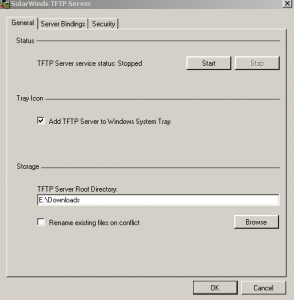
- Start the Service and close this window. The bottom bar of the main window should now confirm that the server runs
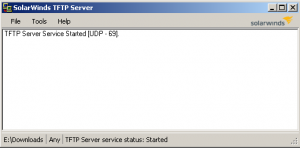
- Make sure all firewalls are disabled or correct configured.
Log in to your switch and go to Administration -> File management – >Upgrade… and select to upgrade the firmware.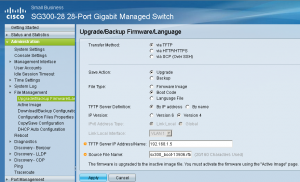
- Follow the procedure displayed by the firmware upgrade process. Once done upgrade the boot code
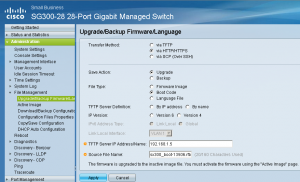
- Again follow the procedure displayed by the firmware upgrade process.Then select to use the new loaded firmware on the next start
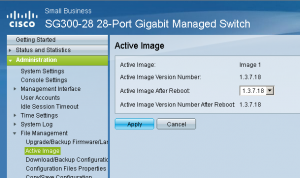
- Do a reboot, Administration -> File management – >Reboot.
Let your switch reboot, it takes some minutes. It will look like dead for a while, do not do anything, don’t unplug the mains, it will boot fine.Its important that all switches have the same firmware version, do this procedure on every switch in your network, or at least on the ones that are used for Dante
- Before you start make sure you have a TFTP client installed on your PC, if not you can use Solarwinds TFTP Server. Once installed download the latest Firmware from the Cisco website.Open Solarwinds TFTP server go to File -> Configure and set the TFTP Root Server Directory to the folder you have placed the Firmware files.
- Set the switch to a static IP settings
In Administration ->Management Interface -> IPv4 Interface set the switch to a free static IP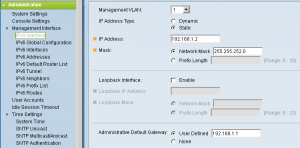
- Define DNS settings
Enable the use of DNS in IP Configuration -> Domain Name System -> DNS Settings and add at least 2 known good DNS servers to the list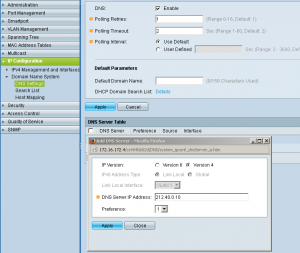
- adjust system time
A very important thing is that the switches are synchronized in time. Not only that the logs are more clear if time is right, the complete network management traffic between the switches is taking advantages of a correct time.- Administration -> Time settings -> System Time enable the Main Clock Source (SNTP Servers) and set also the correct time zone
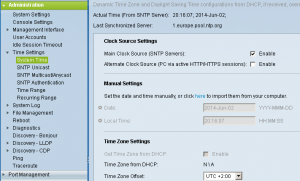
- Enable afterwards the SNTP Client Unicast in Administration -> Time settings -> SNTP Unicast and add at lest two time sources

If the config is correct the status is up and the Last Response is accurate
- Administration -> Time settings -> System Time enable the Main Clock Source (SNTP Servers) and set also the correct time zone
- Create a VLAN for Dante
We assume here that you are already logged in in the Switch..- To create a new VLAN go to Vlan Management -> Vlan Setings an add a new one
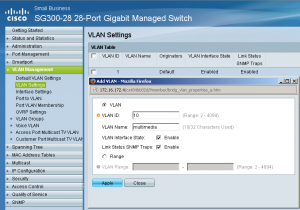
- Next we have to define which port that contains traffic for that virtual lan. But before we have to define the capabilities of each port in therms of VLAN. 3 different port settings can be set in Vlan Management -> Interface Se tings. From Cisco manual:
- General—The interface can support all functions as defined in the IEEE 802.1q specification. The interface can be a tagged or untagged member of one or more VLANs.
- Access—The interface is an untagged member of a single VLAN. A port configured in this mode is known as an access port.
- Trunk—The interface is an untagged member of one VLAN at most, and is a tagged member of zero or more VLANs. A port configured in this mode is known as a trunk port.
- So for us that means that all Dante devices must be connected to a port that is set to access, all ports that are connected to other switches must be Trunk or General

- After we have set our port settings right we do assign which VLAN goes over which port.
A trunk usually transports all VLAN’s to the next switch, therefore we can set the uplink port to transport all VLAN’s
The picture above show that port 1-5 are uplinks to other switches 6-8 are access ports for simple Dante devices. UP means that this VLAN (usually 1) is the default non tagged Lan which is assigned on the port (If you connect your PC without VLAN config on the network card you end up in this network).
T means that this VLAN is tagged only available on this port. The pages VLAN Management -> Port VLAN Membership and VLAN Management -> Ports to VLAN do show and set the same settings.
- To create a new VLAN go to Vlan Management -> Vlan Setings an add a new one
- Disable Energy Efficient Ethernet EEE
Anyhow the Cisco switches are very good in saving energy and disabling partially the ports Dante can be affected by such events. Therefore this service should be disabled. (Not every switch does support EEE, if not available its not built in)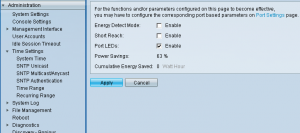
In ports overview it should look like that
- Multicast settings
Dante supports IGMP, a communication protocol to manage multicast. Using that protocol the switch can manage multicast’s and decide which port should be included in the multicast, save CPU and port capacity for ports that are not involved.- First we have to enable the Bridge Multicast Filtering Status in Multicast -> Properties for the VLAN we use for Dante. As Forwarding Method select IP Group Address
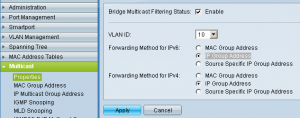
- Each VLAN needs to be enabled with IGMP. In Multicast -> IGMP Snooping select all vlans which contains Dante traffic and enable the IGMP snooping status
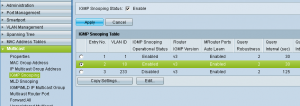
- Select each IGMP enabled VLAN and press edit. Do the following settings
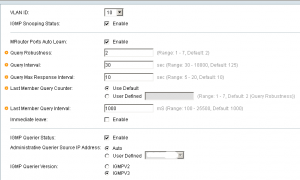
Important: If there are multiple switches in the setup only activate the IGMP Querier on one switch and configure the Multicast Router Port accordingly.
IGMP querier does only work if the switch has a IP address in the same network segment it should query (Querier Source IP Address). Take care if you have VLANS on different network segments, the switch must have a matching IP to send the query’s. Maybe Layer 3 must be activated to achieve this…More info on multi- switch IGMP config: https://confluence.avt.tech/pages/viewpage.action?pageId=51381181. From this step on our switch auto-detects multicast ‘s and forward them to the ports needed. This auto-detect needs to be tuned a little for Dante. - The table in Multicast ->IP Multicast Group Address shows the already detected multicast IP addresses, as well custom addresses can be inserted. So we make sure the two addresses 224.0.1.129 (PTP) and 224.0.0.251 (MDNS) are in this list and assigned to the ports needed (Ports that are included in the Dante VLAN) as static
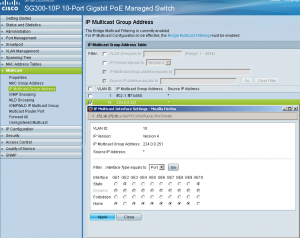
- Looking at Multicast -> Multicast Router
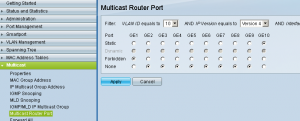
The different settings static, Forbidden, None are explained in the help of the switch. Dynamic means that the switch has detected the port already, so change this to static. Once changed, the switch knows already the correct settings, so after a power loss the right settings are immediately applied, the auto detect delay is gone. - For uplink connections from switch to switch also activate in Multicast -> Multicast Router Port the port to static forward all traffic.

The picture above shows that port 10 is an uplink, port 1 is not disturbed in any case with Dante multicast’s. For devices which are maybe in the same VLAN but are not Dante devices the setting forbidden should be chosen. The two multicast addresses we added are now registered multicast’s, means the switch knows exactly what to do with the traffic. - For Dante audio multicast’s and other devices multicast’s we need to make sure that the unregistered multicast’s are forwarded and auto-detected. Multicast -> Unregistered Multicast let us define exactly this settings. Port 1 does not need any multicast, therefore we define Filtering for this port. All other are in Forwarding mode.
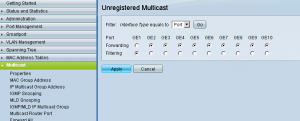
- First we have to enable the Bridge Multicast Filtering Status in Multicast -> Properties for the VLAN we use for Dante. As Forwarding Method select IP Group Address
- Setup QoS to prioritize PTP (Dante clock messages)
- Quality of Service -> General -> QoS Properties set the QoS mode to Advanced
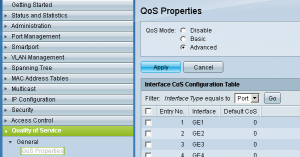
- Then we have to correct the queue settings
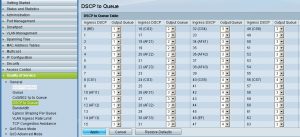
- Quality of Service -> QoS Advanced Mode-> Global Settings we need finally to set the Trust mode to DSCP and the Default Mode Status to Trusted
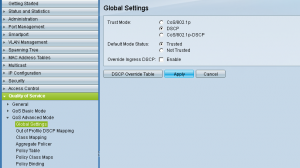
- Quality of Service -> General -> QoS Properties set the QoS mode to Advanced
References:
Yamaha Proaudio setup pages for Dante http://www.yamahaproaudio.com/global/en/training_support/selftraining/dante_guide/index.jsp
Symetrix knowledge-base http://www.symetrix.co/support/knowledge-base/
Technet article Dante networking: Ports and protocols
Audinate website FAQ: https://www.audinate.com/index.php?option=com_content&view=article&id=187
Allen&Heath Understanding Dante http://www.allen-heath.com/media/Understanding+M-DANTE+-+rev+18dec12.pdf
Wikipedia IGMP article http://en.wikipedia.org/wiki/Internet_Group_Management_Protocol
Wikipedia Qos article http://en.wikipedia.org/wiki/Quality_of_service
Cisco integrated help in the switch interface (top right corner)
AVT Tech: https://confluence.avt.tech/pages/viewpage.action?pageId=51381181 or direct link to a PDF of the site TKB-51381181-301018-1616-70

-